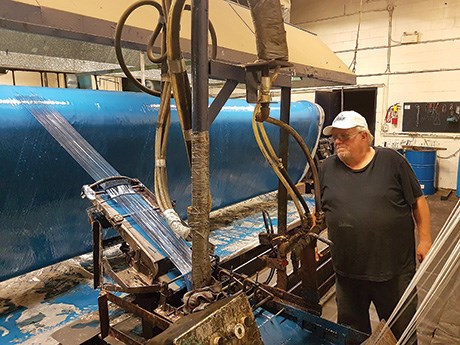Schauenburg Industries launches new rigid fiberglass ducting product
A new rigid ventilation ducting product manufactured by Schauenburg Industries of North Bay promises to save mining companies millions of dollars a year.
Schauenburg spent three years on research and development to improve the efficiency of rigid fiberglass ducting. The primary objective was to reduce the K-factor, or friction factor, a measure of the smoothness of the inside surface of the ducting. “That’s because, “the smoother the surface, the faster the airflow,” said Schauenburg managing director Don Croteau.
With a lower K-factor, mining companies can use smaller fans that consume less electricity.
K-Max ducting, Schauenburg’s new improved product, boasts a K-factor of 9.5, compared with K-factors of 10.5 for rigid plastic ducting, 14 for its previous fiberglass product and 16 for steel ducting.
Based on an installation of 1,000 feet of 48-inch ducting and 50 48-inch fans producing 50,000 CFM of air, the K-Max product saves between $1.25 million and $3.7 million per year when compared with the cost of using rigid plastic or steel ducting, according to Schauenburg’s calculations. That equates to a saving of between 17 and 37 per cent.
The same scenario pushing through 80,000 CFM produces savings of between $490,122 and $4.7 million per year when compared with the cost of using rigid plastic or steel.
“Years ago, the K-factor didn’t matter because energy costs were lower,” said Croteau. “Today, it’s very important. A lot of mines are becoming more energy conscious, so this is good timing for K-Max because we can show that there are energy savings. Ten years ago, it would have been a harder sell because they didn’t care as much.”
The K-Max product was tested at CanmetMINING in Sudbury “because we didn’t want people thinking they were our numbers,” said Croteau.
Schauenburg’s other objectives for K-Max were to improve the joints between the sections of ducting and to produce a stackable product that can be transported more economically.
“A better K-factor is great, but if it’s leaking at every joint in the pipe, the K-factor doesn’t matter,” said Croteau. “So, once you get a better K-factor, the challenge is to make sure the joints aren’t leaking.
“Then, the issue was how to get more on a truck because if you’re shipping 54-inch diameter pipe across Canada, you can only put so many in a truck. You’re shipping air. Transportation is expensive, so we experimented with different tapering so we could stack the pipe like coffee cups.
“We tapered it only enough to allow two to three times more pieces on a truck, but not to affect the integrity or the flow of air through the ducting.”
For a recent shipment of K-Max to Prince George, British Columbia, a distance of close to 4,000 kilometres, Schauenburg was able to load 28 10-foot sections of ducting on a truck instead of the usual 12 pipes.
“Instead of 10 trucks travelling across the country, we can do it with four or five trucks,” said Croteau.
Schauenburg Industries won a big contract from Crosslinx, a consortium responsible for building the new 19-kilometre Eglinton-Crosstown LRT in Toronto, a $5.3 billion light rail transit line that runs underground for 10 kilometres. Aside from the ducting, Schauenburg also supplied fans and heaters for a turnkey solution.
The company also manufactures flexible, lay flat ducting, spiral ducting with coils of wire to go around corners, inflatable stoppings, silencers and air curtains. Both the rigid and lay flat ducting can be manufactured in an oval shape for increased headroom in the mine.
The North Bay operation, a subsidiary of Schauenburg International of Germany, will celebrate its 50th anniversary next year.


